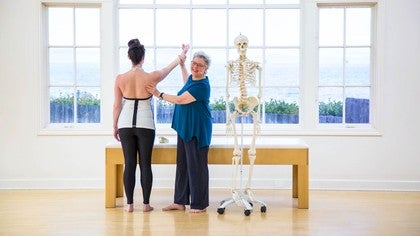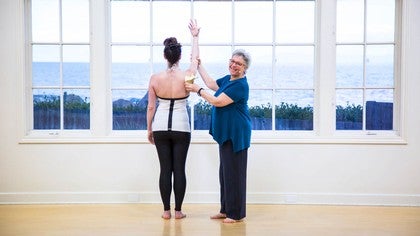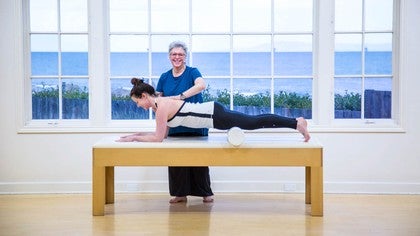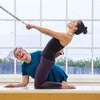Description
About This Video
Transcript
Read Full Transcript
We're going to talk about the shoulder girdle and the bones of the, the rhythms of the bones is called the scapular humeral rhythm. And I have a very big pet peeve about how a lot of teachers are queuing of the shoulders and when you walk in, whether it's yoga or fitness or dance or plots, all you hear is press the shoulders down. Well what is down, I mean what we will federally talk, what helps get the scapula depressed. But a lot of clients are pressing down here. They're pulling down through the ribs. And what we really want to look at is getting the rhythm of the scapular humeral relationship happening. And once you get it correct, you will have great shoulder girdle.
My teacher Irma guard part Tenielle had a fundamental called the hand scapular relationship. And what that means is where your hand is in space, your scapulas relating to it. So if I take my hand up, my scapula's going in upward rotation, if my Scapula, if I, my arm is out to the side, it's in the same relationship to the hat. If I take my arm back, then yes, the shoulder blade could go into downward rotation, like when I have to put a coat on. So we're going to first look at the shoulder blade and what it does and then we're going to look at what the humorous bone needs to do to work with this relationship. And then we're also going to look at what the clavicle does when you, the cue of looking at the clavicle and the spine of the shoulder blade, which is, that is a great reference for you and your client. You meaning the teacher of where their shoulder girdle is.
So now we're going to look on Aaron and see how it relates to a human body. So we're gonna look at um, the scapula and try to have you see how it relates to it on a body. And I want you, this is the back of the scapula and Aaron, can you just turn around? So here's the right shoulder blade and that is called the spine of the shoulder, the shoulder play. And that's ups. There's the medial border and the lateral border.
And what I do a lot. Now turnaround. The other way is I'm sorry it here's her clavicle. Then if you can see it's that way as I draw out to here, that will be the end of the spine of the shoulder blade. If I put my fingertips to the front, you can feel the coracoid process, so now let's have our turnaround and let's talk about the movements, the shoulder blade, so we have elevation and we have depression and elevation and just make sure it's the shoulder blade that's moving down, not the ribs. Then we have retraction or ad duction and we have protraction or ab duction.
Then the other two words that I want you to learn about is upward rotation and that also we talked about earlier is this is the hand scapular relationship so that when Aaron lifts her arm up, that shoulder blade is sliding around her ribs and upward rotation. If she was to take her arm back as if she was going to put a coat on, that would be downward rotation. What I want you to think about is a lot of our clients are already living in downward rotation. So if you start pressing down, turn around for me please. So let's say sh her, she's in downward rotation and the queue is depressed. The shoulder down, she's going to do something not good as well as there's very important nerves underneath here that is called thoracic outlet syndrome. You could be creating more harm than function.
So I want Aaron to turn around again. So what I want you, we're going to help her discover how to get better scapula connection and it's really nice. They love it when you do this. So if I draw, here's the spine of the shoulder blade, she's loving this, and then I'm just drawing the medial border. I'm not going to get too close because I'm probably would tickle her. And then what I'm going to do is watch, let's just watch what she does. So right now her shoulder blade kind of retracted in. So we want to get the pattern of the shoulder blade and I'm taking my fingertips and I'm not. It's very gentle.
It's more to indicate the direction of the movement. And I'm also holding her elbow so that I'm going to lightly get it to move into. So then do you see how that shoulder blade is moving? So that's your upward rotation of the shoulder blade that we want to get for a lot of our movements, like let's say quadriparetic chest rowing front, um, and anything like plank pose. Um, that's really important. Okay, so now we're gonna talk about what the humorous bone is doing and especially in relationship to where the Scapula is. If we look at, here's the humorous bone, and let's say he was in downward rotation and she kept the same rhythm of rotation, she would hit the acromion process. So, and a lot of your dance as well as like, let's say chess rowing front is working with those really good rhythms of the arm. So as I, it starts a little internally rotated as it goes out, it starts externally rotating and this external rotation, you can see the screws there, but it's really gonna free her up to be able to lift the arm up.
I'm going to do bad version. So you see I've internal rotation and I lift my arm up. Do you see my shoulder blade is up the minute I get good scapular upper rotation and humeral head rotation at the right timing, there's going to be a much better function of the shoulder girdle. So what again, what I'm gonna do here is I'm already gonna bring Aaron shoulder blade very wide and if we turn her around we'll, we'll talk a little bit more later on about what the hit the clavicle does. But right now she's a little bit in downward rotation where we're going to get it lit up.
She wants to pull her shoulder blade back and I'm going to pull her shoulder blade wide and I'm going to pull her clavicle wide. So then she has a whole different connection of the shoulder blade and the, the main thing we want to get to is that the rotator cuff muscles are centering that humeral head in the socket correctly. If your shoulder blade is living like this, you could be the smartest person in the world. You're always going to have trouble with shoulder function. So here when she, oh, we're going to go out to the side and I'm not letting her press her clavicle downers, shoulder blade, I'm bringing her humeral head in line with our humerus bone in line with the shoulder blade. And then when we go up, I'm giving a little bit of rotation and that's gonna clear it to be in a better place.
And then we'd kind of just run the film backwards and she wants to pull her shoulder blade down and we're gonna go freedom. There you go. So now we're going to turn around so you can see it from the back. And if you look at, here's the shoulder blade. So in my teaching I'm constantly looking at this relationship and that's telling me where my client's shoulder blade is. So I'm going to get that shoulder blade to be living along the curves of the ribs. It's like shaping around the ribs.
And then when she opens the arm out and she wants to, she wants to add duct and we want to get her to move from there. And then once she comes to here, your dance is designed about this, your porter Bra. You're going to give that rotation and go up. So then do you see how she has a wide back? And then once we come into quadriparetic, once you get this relationship going, you're going to solve hyperextension of the ribs and then you're going to bring the whole thing back down. So we're going to have her do both arms. She's going to reach both.
And so I'm taking my hands and go ahead and widen. Good. Now start humeral rotation. There we go. And look at, that's a beautiful wide back. So now we're going to look at the clavicle. And the thing with the clavicle, um, is we kind of think, we kind of think it's our bones are stuck, but there is movement here.
And so the clavicle attaches. This is the breastbone or the sternum and this is called the Mumu maneuver IOM. And this is the only joint that the shoulder blade lives on. Okay? So what I want, we're going to do a little exercise or whatever. I want you to put your hands like so and so what she's imitating is what the clavicle does, so it has rotation and elevation.
Of course it's degrees, but I want, I'd like to exaggerate things so when she lifts her arm up, her clavicle roles in them, maneuver IOM and then the top of the clavicle we'll lift up and then when it comes down she it rolls back. We're going to do that again. So you roll it. And I do this with all my clients. I just teach it like two minutes and then I go to the next thing just to give them a different awareness. Then what we're going to have her do is we're going to have her bring the arm down and I'm, I'm going to take my hand and I usually just kind of put my hand underneath the clavicle. Again, I'm kind of like attracting it up and I'm very light, but I want her not to press the clavicle down air. Also, you're going to put your right hand here and you're going to say, I pledge allegiance to lift my clavicle up. So when she lifts the arm up, the top of the clavicle needs to rise up and notice when that happens, her shoulder drops.
Then I want her to keep her clavicle high so that the bone, the humerus bone is spinning in that socket. And that's really hard because we have had a lot of queuing of pressing down. So she's going to let that clavicle float up. Imagine there's water coming underneath that clavicle and then come back down. Now turn around for me and do the other side so they can see it.
This side's a little harder for her and what's happening? Not to, I can, I don't know if you can see it, but here's hers, her shoulder blade and if I'm down, do you see how it's living on a slant? So I want it wide and I want it wide and then she's going to slowly and we're getting, here's that clavicle rising. She wants to do it from her back. I think there's some structures tighter in here. There we go. And on this side we'll show you also on the other side. Watch this and rotate, rotate and float.
And see how I get it lifted. It's not up, but it has this beautiful with watch her do it on the other side and she don't let it float. There you go. And now lift your arm up and you see how it's getting wider faster. So I'm going to look at what kind of structures is she pulling down that's changing that scapular humeral clavicle relationship. Okay. And it's such an interesting Q turn around again is is, it's very odd cue.
If the think of this going up is like the Cape going down. So it's, it's, it's very freeing. Once you get it. This should be very easy. It shouldn't weigh a lot. It's only one year into plank pose enhanced Dan's that it, you're, you're really using a lot of physicality. So we just talked about the scapular humeral clavicle rhythms.
We're now going to go look at the rotator cuff muscles and these poor babies are ignored. And I want you to just do this. Just do that. That's how lightly we need to be activating them. But in that dance around the shoulder girdle, it's gonna really help the whole shoulder girdle mechanics and it's going to change her shoulder girdle. What we're looking at is the, the goal, the job of the rotator cuff muscles is the center of the humerus bone in the socket. So, and notice he's a little, there we go. Wherever the elbow moves in space, the humorous bone is going to slide down in the socket. If it goes forward, the humeral head has to slide back.
If it goes back, this thing's not allowing me to do it. It has to go,
I'm keeping that humeral head lightly in the socket, and then I'm going to get my scaffold working as
Embodied Anatomy: Upper Body
Comments
You need to be a subscriber to post a comment.
Please Log In or Create an Account to start your free trial.


























